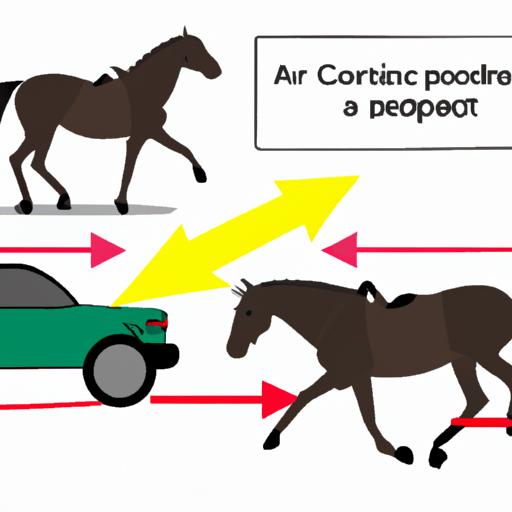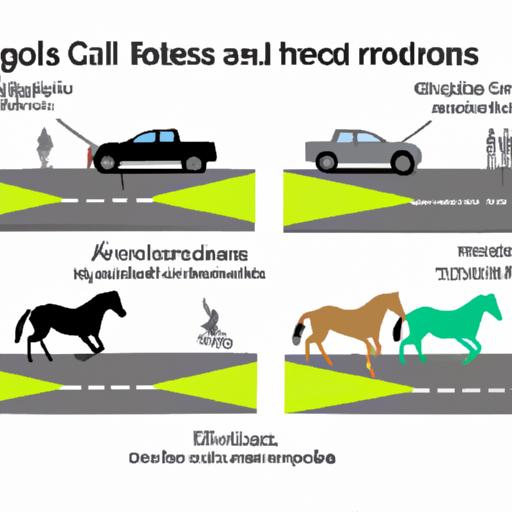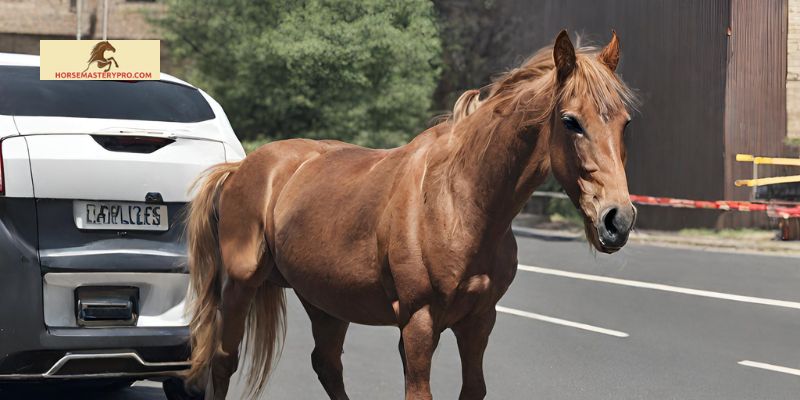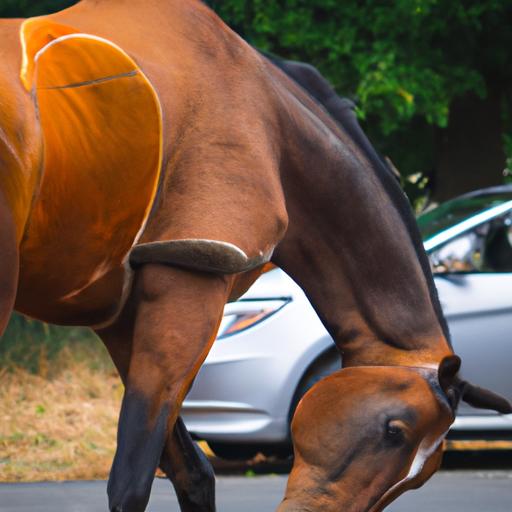Discover the devastating impact of a horse hit by a car. Learn preventive measures to avoid such accidents. Safeguard horses and drivers on the road.
horse hit by car: Accidents involving horses being hit by cars can have devastating consequences, not only for the horses and their owners but also for the drivers involved. It is crucial to comprehend the severity of these incidents and take preventive measures to avoid such tragic collisions. In this article, we will explore the impact of a horse hit by a car, the contributing factors to these accidents, and the necessary steps to prevent them.
A. Brief Overview of the Incident Involving a Horse Hit by a Car

Picture this scenario: a peaceful countryside road, a horse leisurely grazing by the side, and suddenly, a car comes speeding around the corner, resulting in a collision between the two. The consequences can be catastrophic, with the horse suffering severe injuries, and the driver and passengers potentially facing physical harm as well. These incidents not only cause physical damage but also emotional distress to both horse owners and drivers.
B. Importance of Understanding the Consequences and Preventive Measures

Understanding the implications of a horse-car collision is paramount. Horses are majestic creatures, and their well-being should be a priority, not only for owners but for society as a whole. These incidents can lead to serious injuries, such as broken bones, internal damage, or even fatalities. Furthermore, the financial burden of medical treatment for injured horses can be overwhelming for owners. It is essential to comprehend the emotional and financial toll these accidents can have on individuals involved.
Taking preventive measures is the key to avoiding these distressing incidents. By implementing appropriate road signage and markings near horse crossings, drivers can be made aware of the presence of horses in the vicinity, giving them time to slow down and proceed with caution. Additionally, educating drivers about horse behavior and the potential dangers of inattentive driving or speeding in horse-populated areas can significantly reduce the risk of collisions.
By understanding the consequences of a horse hit by a car and implementing preventive measures, we can ensure the safety and well-being of horses, drivers, and passengers alike. In the following sections, we will delve deeper into the impact of such accidents, the contributing factors, and the legal responsibilities associated with them. Let’s work together to create a safer environment for both horses and humans on the roads.
Stay tuned for the next section where we explore the severity of injuries sustained by horses in car accidents and the emotional and financial consequences for horse owners.
Understanding the Impact of a Horse Hit by Car

A. Severity of Injuries Sustained by Horses in Car Accidents
When a horse is hit by a car, the injuries sustained can be devastating. The sheer force of the impact can lead to broken bones, internal bleeding, and severe trauma. Horses are large and powerful animals, but even they are vulnerable to the weight and speed of a car. The extent of the injuries can vary, ranging from minor bruises and cuts to life-threatening conditions.
In some cases, horses may suffer fractures in their legs or pelvis, making it impossible for them to stand or move. These injuries often require immediate veterinary attention and may necessitate surgeries or prolonged periods of rest and rehabilitation. The recovery process can be lengthy and costly, placing a significant burden on horse owners.
B. Emotional and Financial Consequences for Horse Owners
Horse owners are not only confronted with the physical well-being of their beloved animals but also the emotional toll of witnessing such accidents. The bond between a horse and its owner is profound, and any harm inflicted upon the horse can cause immense distress. The emotional trauma experienced by owners cannot be underestimated.
Furthermore, the financial implications of a horse-car collision can be overwhelming. Veterinary bills, medications, and specialized treatments can quickly accumulate, placing a strain on the owner’s finances. Additionally, horses that are unable to participate in activities such as competitions or riding lessons due to their injuries can result in a loss of income for owners who rely on these activities for financial stability.
C. Risks Posed to Drivers and Passengers in Car Collisions with Horses
Car collisions with horses not only endanger the horses and their owners but also pose significant risks to drivers and passengers. When a vehicle collides with a horse, the impact can cause severe damage to the car, potentially leading to injuries or even fatalities for those inside. The suddenness of these accidents and the size of the animal involved can make it challenging for drivers to react swiftly, increasing the likelihood of severe consequences.
In addition to the physical harm caused, these incidents can also result in psychological trauma for drivers and passengers. Witnessing a horse-car collision can be distressing and may leave individuals with long-lasting emotional scars. It is crucial to recognize the potential risks involved in order to emphasize the importance of preventive measures and responsible driving in areas with horse crossings.
Stay tuned for the next section where we explore the contributing factors to horse-car collisions, including the lack of proper signage and road markings, as well as the role of driver inattentiveness and speeding.
Factors Contributing to Horse-Car Collisions
Horse-car collisions can often be attributed to a combination of factors that contribute to these unfortunate accidents. Understanding these factors is crucial in order to address them effectively and minimize the risk of such incidents. Let’s explore the key contributors to horse-car collisions:
A. Lack of Proper Signage and Road Markings in Areas with Horse Crossings
One of the major factors leading to horse-car collisions is the absence of adequate signage and road markings in areas where horse crossings are common. Insufficient signage fails to alert drivers to the presence of horses on the road, increasing the chances of a collision. By implementing clear and visible signage, drivers can be alerted in advance, allowing them to adjust their speed and exercise caution when approaching these areas.
B. Inattentive Driving and Speeding as Common Causes
Inattentive driving and speeding are significant contributors to horse-car collisions. Drivers who are distracted by their phones, conversations, or other factors may fail to notice horses on or near the road until it’s too late to react. Additionally, speeding reduces the driver’s ability to respond promptly, increasing the likelihood of a collision with a horse. It is crucial for drivers to remain vigilant and maintain a safe speed, especially in areas where horses are known to frequent.
C. Importance of Educating Drivers about Horse Behavior and Potential Dangers
Educating drivers about horse behavior and the potential dangers associated with horse-car collisions is essential to prevent these accidents. Many drivers may not be aware of how horses may react to loud noises, sudden movements, or the presence of vehicles. By providing education and raising awareness about the behavior and needs of horses, drivers can better understand how to navigate around them safely. This knowledge can help drivers anticipate and avoid potential hazards, reducing the risk of collisions.
By addressing the lack of proper signage, promoting attentive driving, and educating drivers about horse behavior and potential dangers, we can significantly reduce the occurrence of horse-car collisions. In the next section, we will explore the preventive measures that can be taken to avoid these accidents and ensure the safety of both horses and drivers on the road.
Stay tuned for the next section where we discuss the preventive measures that can be implemented to avoid horse-car accidents.
Preventive Measures to Avoid Horse-Car Accidents
Ensuring the safety of horses and minimizing the occurrence of horse-car accidents requires proactive measures and collective efforts. By implementing preventive measures, we can significantly reduce the risk of these collisions. Let’s explore some effective strategies that can help avoid horse-car accidents.
A. Implementing Appropriate Road Signage and Markings near Horse Crossings
One crucial step in preventing horse-car accidents is the installation of clear and visible road signage and markings near horse crossings. These indicators serve as a visual reminder for drivers to exercise caution and be aware of the potential presence of horses on the road. Proper signage can include warnings, such as “Caution: Horse Crossing,” accompanied by appropriate symbols, ensuring that drivers are adequately informed and prepared to adjust their speed and behavior accordingly.
B. Encouraging Responsible Driving and Reduced Speeds in Horse-Populated Areas
Responsible driving plays a vital role in preventing accidents involving horses. It is crucial for drivers to understand the significance of reducing their speed in horse-populated areas. By maintaining a slower pace, drivers have more time to react to unexpected situations, such as a horse suddenly crossing the road. Moreover, slower speeds reduce the severity of potential collisions and provide horses and riders with a safer environment.
C. Promoting Awareness Campaigns to Educate Drivers about Horse Behavior and Cautionary Measures
Raising awareness among drivers about horse behavior and cautionary measures is fundamental in preventing horse-car accidents. Education campaigns can inform drivers about the nature of horses, their potential reactions to certain stimuli, and the appropriate actions to take when encountering them on the road. This knowledge empowers drivers to anticipate and respond appropriately, reducing the likelihood of accidents.
By implementing appropriate road signage and markings, encouraging responsible driving in horse-populated areas, and promoting awareness campaigns, we can create a safer environment for both horses and drivers. It is essential to remember that prevention starts with each individual’s commitment to being vigilant and considerate on the roads. Together, let’s strive towards a future with fewer horse-car accidents.
Stay tuned for the next section where we delve into the legal implications and responsibilities associated with horse-car accidents.
Legal Implications and Responsibilities
A. Laws and Regulations Regarding Horse-Crossing Areas and Driver Responsibilities
When it comes to horse-car accidents, understanding the legal framework and responsibilities is crucial. Many jurisdictions have specific laws and regulations that govern horse-crossing areas and outline the responsibilities of drivers. These laws are designed to ensure the safety of both horses and drivers on the road.
In some regions, there are designated horse-crossing areas with proper signage and road markings to alert drivers of the potential presence of horses. It is important for drivers to be aware of these designated areas and exercise caution when approaching them. Failure to adhere to these regulations can have serious consequences.
B. Consequences for Drivers Involved in Horse-Car Accidents
Drivers involved in horse-car accidents may face legal repercussions depending on the circumstances. If it is found that the driver was negligent, such as driving recklessly or failing to observe horse-crossing signs, they may be held liable for the damages caused. This can include financial penalties, points on their driving record, and potential legal action from horse owners or authorities.
Moreover, drivers may also face personal consequences such as increased insurance premiums, loss of driving privileges, or even criminal charges if their actions are deemed particularly egregious or resulted in severe harm to the horse or individuals involved.
C. Importance of Reporting Incidents and Cooperating with Authorities
In the event of a horse-car accident, it is crucial to report the incident to the relevant authorities immediately. This not only ensures that proper documentation is in place but also allows authorities to investigate the incident thoroughly. By reporting the incident, you contribute to the creation of accurate statistics that can help identify problem areas and improve safety measures in the future.
Cooperating with authorities during the investigation is essential. Providing them with all the necessary information, including eyewitness accounts and any available evidence, helps establish a clear picture of what transpired. This cooperation not only aids in determining fault but also helps ensure that justice is served and appropriate measures are taken to prevent similar incidents in the future.
By understanding the legal implications and responsibilities surrounding horse-car accidents, we can work towards creating a safer environment for all road users. In the next section, we will explore the support and assistance available for horse owners and injured horses affected by these accidents.
Stay tuned for the next section where we discuss the resources and support available for horse owners dealing with accidents.


